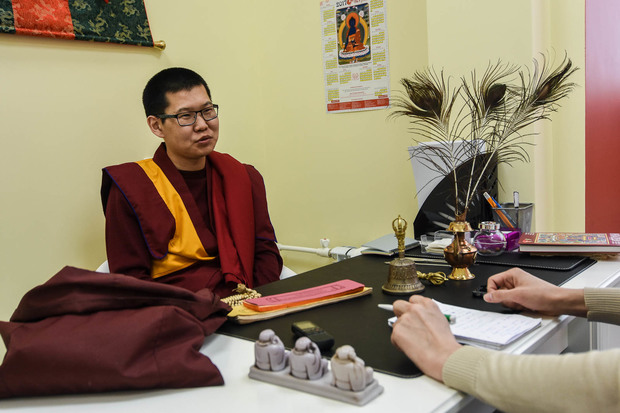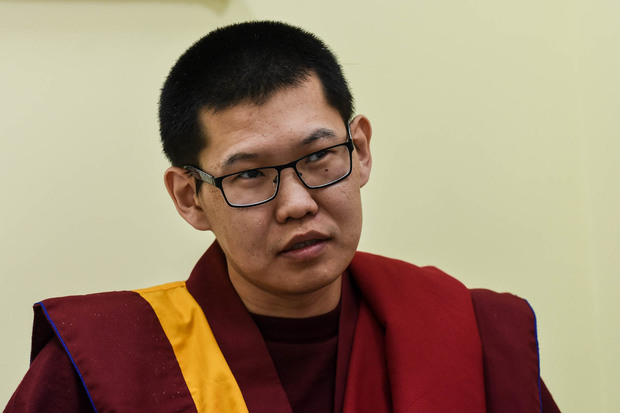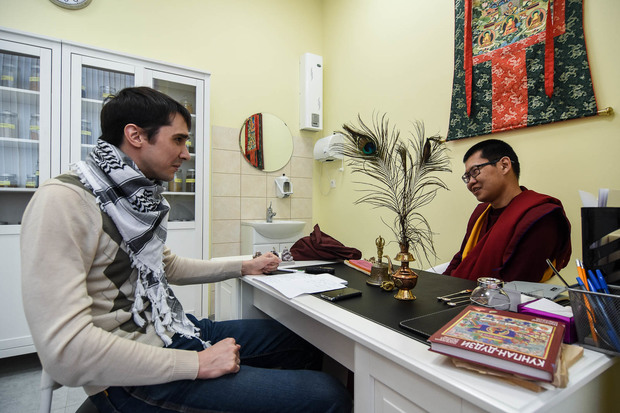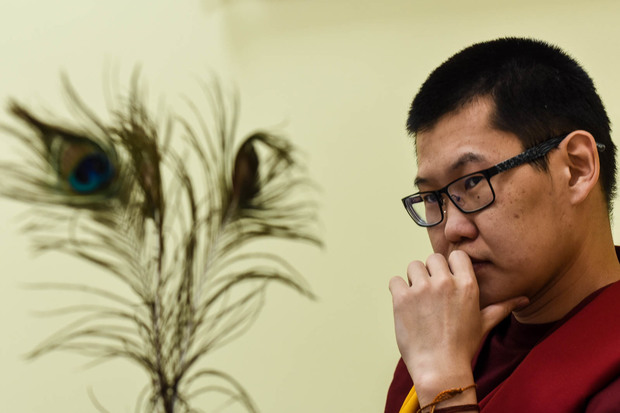Chief of Kazan Buddhists: about construction of the temple, dangers of veganism and Zilant’s links with India
Exclusive interview of Realnoe Vremya with the main abbot of the Buddhist community in Kazan Garmazhap Matovarov
In 2016, Realnoe Vremya published the interview with chairman of the National-cultural autonomy of Buryats of Kazan Sesegma Bubeyeva, who told about the start of an ambitious project of building a Buddhist temple in the capital of Tatarstan with the participation of a sculptor Dasha Namdakova. This news have caused heated discussions among ordinary citizens and experts. Recently arrived in Kazan the main Abbot of the Buddhist community of Kazan, Garmazhap gebshi Lama Matovarov. In conversation with the correspondent of our newspaper, the priest told about the construction of the datsan, about ''snake'' parallels of Zilants and Indian nagas, and other things.
''Construction of the dastan is the beginning of the joint project''
Garmazhap Lama, first of all, I would like to know what is your main mission in Kazan?
The main mission, of course, is associated with the construction of a Buddhist temple. In addition to the construction, I am going to help people not only in the religious aspect but also in Buddhist one, as well as in health, in the field of health promotion. That is, I have three goals: first, the construction of the temple; second, carrying out religious rites in terms of Buddhism; third, to help all people of Kazan to be healthier.
Have you met with a sculptor Dashinima Namdakov under the auspices of whom the project was born?
Not yet. It should be understood that the construction of the datsan is the beginning of the joint project. This project is not only religious, but also cultural: it is designed to show Buryat, Buddhist cultures. We can show various aspects of the traditional life. Of course, there will be also a spiritual goal: for believing Buryats, Kalmyks, Tuvinians, Mongols, Chinese, Koreans and Vietnamese, this temple is very important, they need a place to hold prayer services, where they could come, to attend khurals, to take part in annual ceremonies. Before the Buddhist New Year, they hold several large religious ceremonies. In the spring and early summer they usually hold events dedicated to the month of Visak (or, in Buryat — Buyantai hapa) — this month is associated with the day when Buddha Shakyamuni had birth, enlightenment and achieved nirvana.

The construction of the datsan is the beginning of the joint project. This project is not only religious, but also cultural: it is designed to show Buryat, Buddhist cultures
''There was a request from Kazan for a lama-priest''
Coming of the first permanent abbot of the Buddhist community in Kazan is quite important and unique event. Have you already agreed meetings with the representatives of the Muslims of the region, mufti Kamil Samigullin, and Orthodox Metropolitan, Bishop Feofan?
I am sure that such meetings will take place soon. We are planning to hold official visits to them.
Tell us about yourself. Who is he — the head of the Buddhist community in Kazan?
I was born in Buryatia in 1985. After nine years of secondary school, I went to study in Ivolginsky datsan — the center of Buddhism in the country, where the residence of the head of the Buddhist traditional Sangha of Russia is located. It is 30 km away from Ulan-Ude, there is the Buddhist University — the only place in Russia where you can receive higher Buddhist education, it is a kind of a seminary or madrasah. There are several areas of study, but the main is the Buddhist Philosophy. However, the concept ''Philosophy'' here is quite different from the term which we usually understand — ancient, Kantian, Nietzschean or modern. Buddhist Philosophy is a basic course of education that provides basic knowledge necessary for a Buddhist priest. I started to study this course. Then I continued my education in South India, there is the University of Drepung Gomang. After graduation I returned to Buryatia in 2012, I began teaching at the Buddhist University. After 4-5 years, I went to India again for a kind of further training, retraining. Here I studied Tibetan medicine. At the end of last year, I returned to Russia and after a short time I was sent here.

In Ulan-Ude, there is the Buddhist University — the only place in Russia where you can receive higher Buddhist education, it is a kind of a seminary or madrasah. There are several areas of study, but the main is the Buddhist Philosophy
Garmazhap Lama, did you volunteer to go to Kazan or you were sent by someone senior?
By numerous requests of believers, ethnic Buddhists, Buryat Association of the city of Kazan there was a request for a lama-priest with certain characteristics. At that time I was free and fitted the characteristic. I've turned out to be in Kazan by the play of chance.
''It is impossible to be in only one position all your life''
During my last conversation with Sesegma Bubeyeva she said that there are lamas specialising in different areas — healers-herbalists, chiropractors, astrologers, and people of prayer. What is your specialty?
I combine philosophical and medical areas. There are lamas who possess any knowledge or gift and know how to help a person. I have more herbal medicine, nutrition tips, body built. It is often said that you can treat a disease by adjusting nutrition and lifestyle. These things are among the reasons that cause a disease.
You are here as an interim rector until the temple is built, or you are going to put down roots?
Now we are working on preparations for the construction. Then it will be the construction itself. At some of these moments, there will be approved the rector. But it's not a permanent position: it is impossible always be abbot, it is a temporary position. Everything in life is temporary, and I'm not trying to associate myself with any position. They say that you should change job in life every 4-5 years. But our calling of Lama: regardless of position and place, to understand our key goals — long term and short term ones. The construction of the datsan and the other – they are temporary goals.

They say that you should change job in life every 4-5 years. But our calling of Lama: regardless of position and place, to understand our key goals — long term and short term ones
I've heard that Buddhists don't eat meat. Is it true?
I do eat meat. There are Buddhists who adhere to vegetarian diets. From the point of view of medicine, health preservation, long-term vegetarianism, veganism and especially raw food cause serious harm to body, digestive system. What is even worse, many families deprive their children of meat, not even asking them. The rejection of animal products, including milk, butter, eggs, is very harmful to a growing organism, they are very necessary for children.
Who provides you support, I mean financially?
We shift on ourselves. In general, lamas don't have a permanent source of income, as well as priests of Orthodoxy and Islam. It is clear that they live on the donations of parishioners. But here here Buddhist congregation is quite small. Although, over half a year, as I found out, the number of Buryats in the city has doubled — now there are about 150 people. Here began to contact other ethnic Buddhiss — Kalmyks. Soon, I think we will receive Tuvans, Vietnamese, Chinese, Koreans. Everything is just beginning, we are beginning to accept everyone who wish, we are starting lectures on Tibetan medicine, which we hold on Saturdays. The topics covered in the lectures, for example, ''nutrition according to the seasons, region, body constitution and properties of products'' will be interesting and useful not only to believers but also to all residents of Tatarstan. They will be held in the Center of Oriental medicine Chzhud-Shi on the Galimdzhana Barudi, 20a (here is the temporary residence of the Lama — editor's note).
''The history of Kazan is associated with snakes''
You are in Kazan for already several days. Do you like the city and how have the locals perceived you?
I would like to note that Kazan is a very beautiful city. This beauty is very harmonious — architecture, roads, general view. I've really liked that the city that it is open to tourists, there are many attractions. Kazan citizens are very friendly people, anyway, I've drawn this conclusion by people I have met with. I hardly know the city, I often turn to passers-by, asking them, they always help.

I've become very interested in the origins of the city. I heard that the city was founded on the Snake mountain (Zilantov's mountain – editor's note), its history is associated with snakes. There is a parallels with the creatures of Naga in Indian mythology, in Buddhism
Do you feel here some different energetics?
I've become very interested in the origins of the city. I heard that the city was founded on the Snake mountain (Zilantov's mountain – editor's note), its history is associated with snakes. There are parallels with the creatures of Naga in Indian mythology in Buddhism. They are snakelike creations, keepers of water, water sources and treasures. In Buddhism, there is the great teacher Nagarjuna, who penetrated in the Kingdom of the Nagas and received the teachings that were concealed. It was one of the great Indian philosophers. He received fundamental knowledge of the middle way. Nagarjuna explained to people the laws of the world. Once in the rainy season the King of Nagas (snakes) came to Shakyamuni Buddha when he was meditating and closed him from the rain by opening a hood. There is even a famous statue.